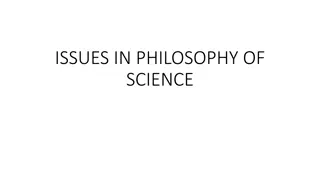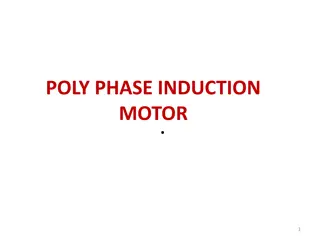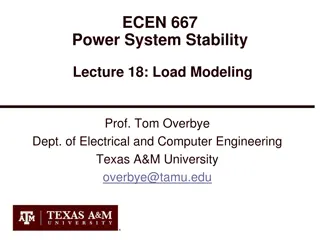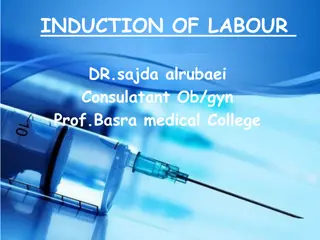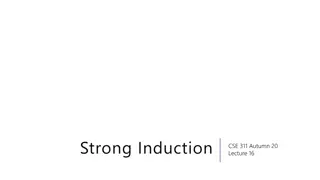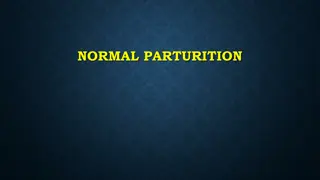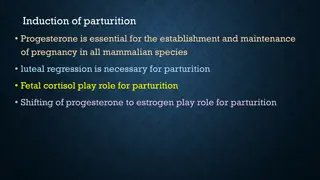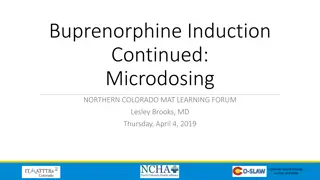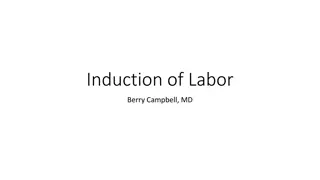Understanding Induction of Parturition in Animals
Explore the process of inducing and terminating parturition in animals, including the hormonal changes associated with pregnancy, fetal nutritional demands, and indications for induction. Learn about the role of oxytocin, adrenal changes in fetuses, and various methods used for inducing parturition.
Download Presentation

Please find below an Image/Link to download the presentation.
The content on the website is provided AS IS for your information and personal use only. It may not be sold, licensed, or shared on other websites without obtaining consent from the author. Download presentation by click this link. If you encounter any issues during the download, it is possible that the publisher has removed the file from their server.
E N D
Presentation Transcript
INDUCTION INDUCTION OF TERMINATION TERMINATION OF OF PARTURITION PARTURITION & ELECTIVE OF PREGNANCY PREGNANCY IN & ELECTIVE IN ANIMALS ANIMALS
Fetal Nutritional Demands CRH ACTH PARTURITION Pituitary Anterior Adrenal Cortex Hypothalamus Placental Insufficiency Fetal Corticosteroids (Cortisol)
Fetal Nutritional Demands CRH ACTH PARTURITION Pituitary Anterior Adrenal Cortex Hypothalamus Placental Insufficiency Fetal Corticosteroids (Cortisol) Lung Liver (glycogen) Thyroid (metabolism) Placentome (surfactant) Progesterone Estrogen PGF2
Fetal Nutritional Demands CRH ACTH PARTURITION Pituitary Anterior Adrenal Cortex Hypothalamus Placental Insufficiency Fetal Corticosteroids (Cortisol) Lung Liver (glycogen) Thyroid (metabolism) Placentome (surfactant) Progesterone Estrogen PGF2 Uterine Myometrium Gapjunctions Uterine Endometrium Oxytocinreceptors Cow,Sow Triggers CL Regression PGF2 Oxytocin Ovary (CL) Cervical Ripening Uterine Contractions Relaxin
FINAL ROLE OF OXYTOCIN Sensory Neurons in Cervix Oxytocin from Posterior Pituitary Myometrial Contractions
FETAL ADRENAL CHANGES WITH AGE Change in Adrenal Size is a Response to Stress!! Lack of space Lack of gas exchange Lack of nutrients Adrenal Gland Weight Parturition FetalAge
INDICATIONS During normal gestation Misidentification of a breeding female Accidental breeding of a very young heifer, and Unwanted pregnancy in feedlot heifers. During abnormal gestation Fetal maceration, Fetal mummification Hydramnios, and hydrallantois.
INDUCTION OF PARTURITION Dexamethazone Potent synthetic cortisol Works in all species Takes 2 to 3 days PGF2a Swine, cattle and sheep Oxytocin Human, horse
PGF2 results in luteolysis at any stage of pregnancy; PGF2 treatment alone induces abortion only up to 5 months of gestation. Rarely, luteolysis is incomplete, (luteal progesterone remains above the threshold), and partial cervical dilation and abdominal straining may occur before the cow resumes normal gestation.
GLUCOCORTICOIDS Reduce placental progesterone secretion from 150 days of gestation. Luteal progesterone level is unaffected, induces abortion the last month of gestation. During the final month of gestation, glucocorticoids act at the feto-placental unit to increase the production of oestradiol and PGF2 , resulting in induced parturition. A combination of PG and glucocorticoids will induce abortion from 150 days of gestation.
OESTROGENS During the first 2 to 3 days after ovulation, administration of E2 alters oviductal transport of the bovine embryo and terminatespregnancy. After corpus luteum formation, estrogens cause luteolysis by inducing the endogenous PGF2 luteolytic cascade from the endometrium. abortion can be induced reliably at up to 150 days of gestation. 30mg estradiol valerate, alone or in combination with dexamethasone in cows between 200 and 220 days of gestation has not been shown to decrease serum progesterone or result in abortion.
INDUCTION OF PARTURITION IN COW Caution: Do not induce before day 269 of gestation Methods Dexamethasone oparturition in 48 hours oDexa. + PGF induces within 35 2 hrs oHigh incidence of retained placenta Estrogen given before Dexa. eases parturition. PGF oWorks near term but may require long acting or 2 doses oUsed to remove mumified fetus.
INDUCTION OF PARTURITION IN EWE Dexamethasone Parturition within 24 72 hrs No retained placenta problem. PGF2a Lutalyse works best to abort prior to day 50 multiple injections will work to induce parturition near term
INDUCTION OF PARTURITION IN THE SOW Survival only after day 111 of gestation PGF2a Parturition within 24 48 hrs PGF at 8 AM followed by oxytocin 24 hrs latter Sows farrow between 8 AM and 5 PM following oxytocin Farrowing:1 to 8 hrs. with 15 min interval b/w piglets. Oxytocin can be given if delay in expulsion of subsequent piglet is noticed. decrease stillbirth occurs in large litters or after extended parturition
INDUCTION OF PARTURITION IN THE MARE Do not do this unless absolute need!!! Variable length of gestation in mare Not sure of foal maturity Oxytocin after day 320 Problems Foal may require extensive veterinary care in first few weeks of life impacton social maturity of foal Colostrum in mare Lung maturity in foal
INDICATIONS Mismating Change in ownership Age or health of dam Abnormal gestation, and Twin pregnancy.
TERMINATION OF PREGNANCY UP TO150 DAYS Prostaglandins Upto 5 months of pregnancy. PGF2 or an analogue PGF2 : 25 mg IM Cloprostenol: 500 g IM Fenprostalene: 1 mg SC
Intrauterine infusion of irritating solutions Between days 5 and 10 after ovulation, prevents the establishment of pregnancy and may cause luteolysis and early return to oestrus. Later than 11 days after ovulation occasionally lengthens the oestrous cycle. Up to 90 days of gestation, causes embryonic death necessitating manual evacuation of uterine contents. Suitable solutions Aqueous iodine 0.5% Tetracycline 2 Gm in saline.
Oxytocin First few days after ovulation may prevent the establishment of pregnancy Oestrogens Administration within 72 h of ovulation impedes oviductal transit of embryos. Up to 5 months of gestation, administration of an oestradiol ester, such as oestradiol valerate, results in abortion within 7 days. Occasional abortions occur up to 14 days after treatment. Oestradiol should be administered every 4 days until abortion. Diethylstilesterol: 40-80 mg IM Oestradiol ester: 4-8 mg IM
MANUALTECHNIQUES 1.Manual enucleation of the CL By transrectal manipulation manual enucleation of CL removes progesterone support for pregnancy and results in abortion at up to 150 days. Conceptus will be aborted in 2-5 days late or resorbed. Limitations Induce adhesions of the ovary and ovarian bursa Occasionally, severe hemorrhage, sometimes fatal.
2.Manual rupture of the amniotic vesicle By transrectal manipulation it is possible to manually rupture once the vesicle can be palpated at 30 to 35 days of gestation. After 60 days and up to 120 days of gestation, it is possible to terminate pregnancy by manual decapitation of the fetus. The mean time to abortion is 25 days, but abortion may occur up to 8 weeks after treatment.
IN HYDRALLANTOIS AND HYDRAMNIOS Pregnancy can be terminated within 48 h in cows with simultaneous administration of PGF2 and dexamethasone. Supportive treatment is necessary to compensate fluid loss. Parturition usually is abnormal. C-section may be an alternative to induced parturition.
IN FETAL MUMMIFICATION PGF2 or an analogue Therapeutic agent of choice. Expulsion of the fetus : 24-72 h. return to fertility within 1-3 months. Retreatmentoccationally Oestrogens Luteolytic doses of estrogen also results in expulsion of mummified fetuses. Repeated treatments may be necessary at 48 h intervals. After treatment, the mummified fetus may become lodged in the vagina, requiring lubrication and manual removal.
MTP Mismated dogs that may be too young or small for breeding, may be held in reserve for breeding at some future date, or scheduled to be bred to a different stud. Injury or disease that may compromise the life
DURING PRE-OSSIFICATION PERIOD IN CANINE ( Days 20-22 through 40 -42 after LH peak ) Drugs Dose Route Frequency PGF2 alpha 0.1-0.25 mg/kg SC BID for 4-6 days Cloprostenol 1.0-2.5 g/kg SC Once a day for 5 days Cabergoline Plus Cloprostenol 5 g/kg 1 g/kg Oral SC Once a day for 5 days Once in 48 h Bromocriptine Plus Cloprostenol 30 g/kg 1 g/kg Oral SC TID On days 28 and 32 after LH peak Bromocriptine PlusPGF2 alpha 10 g/kg 100 g/kg Oral SC TID TID Aglepristone 10 mg/kg SC Once a day for 2 days
DURING PREATTACHMENT PERIOD IN CANINE DURING PRE-ATTACHMENT PERIOD IN CANINE (Fertilization to days 20-22 after LH peak) Drugs Dose Route Frequency Aglepristone 10 mg/kg SC Once a day for 2 days Oestradiol Benzoate 10 g/kg (max 1 g) SC Divided in to 2-3 injections / once in 48 h. Begin 2-4 days after mating Cloprostenol 1.0-2.5 g/kg SC BID to QID for 5 days begining of day 5 of diestrus Natural PGF2 alpha 10-250 g/kg SC BID to QID, days 5-11 of diestrus
THANK THANKYOU YOU










